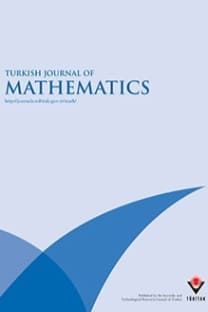Coloring hypercomplete and hyperpath graphs
Kneser graphs and hypergraphs, chromatic and fractional chromatic numbers, hypercomplete and hyperpath (hyper)graphs
Coloring hypercomplete and hyperpath graphs
Kneser graphs and hypergraphs, chromatic and fractional chromatic numbers, hypercomplete and hyperpath (hyper)graphs,
___
- Alon N, Frankl P, Lov´ asz L. The chromatic number of Kneser hypergraphs. Trans Amer Math Soc 1986; 298: 359–370.
- Alon N, Lubetzky E. Independent sets in tensor graph powers. J Graph Theory 2007; 54: 73–87.
- Brandstadt A, Le VB, Spinrad JP. Graph Classes: A Survey. Philadelphia, PA, USA: SIAM Monographs on Discrete Mathematics and Applications, 1999.
- Erd¨ os P. Problems and results in combinatorial analysis. In: International Colloquium on Combinatorial Theory 19 Rome: Acad Naz Lincei, 1976; 3–17.
- Hamburger P, Por A, Walsh M. Kneser representations of graphs. SIAM J Discrete Math 2009; 23: 1071–1081.
- Hilton AJW, Spencer CL. A graph-theoretical generalizations of Berge’s analogue of the Erd¨ os-Ko-Rado theorem. Trends in Math 2006; 225–242.
- Katona GOH. A simple proof of the Erd¨ os-Chao Ko-Rado theorem. J Combin Theory Ser B 1972; 13: 183–184. Kneser M. Jahresbericht der Deuctschen Mathematiker-Vereinigung. Aufgabe 360, Ableilung 1978; 58:2: S 27.
- Kriz I. Equivariant cohomology and lower bounds for chromatic numbers. Trans Amer Math Soc 1992; 333: 567–577.
- Lange C, Ziegler G. On generalized Kneser hypergraph colorings. J Combin Theory Ser A 2007; 114: 159–166.
- Lov´ asz L. Kneser’s conjecture, chromatic number, and homotopy. J Combin Theory Ser A 1978; 25: 319–324.
- Matou ˇ s ek J. Using the Borsuk-Ulam Theorem: Lectures on Topological Methods in Combinatorics and Geometry. Heidelberg: Springer-Verlag, 2003.
- Sarkaria K. A generalized Kneser conjecture. J Combin Theory Ser B 1990; 49: 236–240.
- Scheinerman E, Ullman D. Fractional Graph Theory. New York: Wiley-Interscience, 1997.
- Schrijver A. Vertex-critical subgraphs of Kneser graphs. Nieuw Arch Wiskd III Ser 1978; 26: 454–461.
- Stahl S. n-tuple colorings and associated graphs. J Combin Theory Ser B 1976; 20: 185–203.
- Ziegler G. Generalized Kneser coloring theorems with combinatorial proofs. Inventiones Math 2002; 147: 671–691.
- ISSN: 1300-0098
- Yayın Aralığı: 6
- Yayıncı: TÜBİTAK
Kernel operators on the upper half-space: boundedness and compactness criteria
Muhammad ASIF, Usman ASHRAF, Alexander MESKHI
On direct products of S-posets satisfying flatness properties
On Betti series of the universal modules of second order derivations of k[x1,x2,...,xs] (f)
Ali ERDOGAN, Halise Melis AKCIN TEKIN
On the structure of some modules over generalized soluble groups
Leonid Andreevich KURDACHENKO, Igor Yakov SUBBOTIN, Vasiliy Anatolievich CHUPORDYA
Geometry of almost Cliffordian manifolds: classes of subordinated connections
On Kakutani--Krein and Maeda--Ogasawara spaces
Coloring hypercomplete and hyperpath graphs
On Kakutani Krein and Maeda Ogasawara spaces
Conformally parallel Spin(7) structures on solvmanifolds
On Betti series of the universal modules of second order derivations of \frac{k[x1,x2,...,xs]}{(f)}
